Contents
Q1. What Is Defined As “Income”?
You must pay income tax on all types of income, including income from your business or profession, employment, dividends, interest, discounts, rent, royalties, premiums, pensions, annuities, and others.
For salaried employees, this not only includes your monthly salary, but also things like bonuses, overtime, commissions, and all other taxable income that you received in that particular year.
Q2. Who Needs To Pay Income Tax?
Any individual earning more than RM34,000 per annum (or roughly RM2,833.33 per month) after EPF deductions has to register a tax file.
You don’t have to pay taxes in Malaysia if you have been employed in the country for less than 60 days or for income that is earned from outside Malaysia.
It is advisable for those who earn lesser than the amount stated earlier to also file in their tax to keep a good record of their credit history.
Understanding Tax Rates And Chargeable Income
Here are the income tax rates for personal income tax in Malaysia for YA 2019 (i.e. Year of Assessment 2019).
Example Scenario
Your annual taxable income is RM48,000. Based on this amount, the income tax to pay the government is RM1,640 (at a rate of 8%). However, if you claimed RM13,500 in tax deductions and tax reliefs, your chargeable income would reduce to RM34,500. This would enable you to drop down your tax bracket to 3% instead. Which means, you only require to pay RM585. That’s a difference of RM1,055 in taxes!
Please note that chargeable income is your taxable income AFTER deducting any tax deductions and tax relief. It’s very important you know how it works because as you can see, the tax rate you are charged with increases as your chargeable income does. The more you reduce your chargeable income through tax reliefs, the lesser your final tax amount will be!
Q3. When Do I Need To File (Submit) Online for My Income Tax Form?
- For the BE form (resident individuals who do not carry on business) the deadline is usually mid-May for e-Filing.
- This year deadlineshould
15 May May 2020 via e-Filingextended to Jun 30, 2020 due to MCO
- This year deadlineshould
- For the B form (resident individuals who carry on business) the deadline is usually the end of mid-July for e-Filing.
- This year deadline
15 July for e-Filingextended to Aug 30, 2020 due to MCO.
- This year deadline
- Important note: The Inland Revenue Board (IRB) in a statement in Mar 2020 announced that deadline to submit income tax return forms has been extended for 2 months due to the Movement Control Order (MCO) which is starting from March 18 until March 31. You can file your taxes online via ezHASiL on the LHDN website.
Q4. How Do I File My Income Tax – Is There A Form To Fill?
Step 1. Register as a first-time taxpayer on LHDN e-Daftar
Before you can file your taxes online, you need to be able to log into ezHaSiL. To do so, you need to do the following.
- Register on e-Daftar to get your income tax number.
- Get your PIN number from the nearest LHDN branch to log in to ezHASiL for the first time.
Step 2. Log in to ezHASiL and access e-Filing
Once you have successfully logged into ezHASiL, click on e-filing.
Step 3. Select Your Income Tax Return Form (ITRF)
Here are the different types of ITRFs depending on which category you fall under as shown below. Select the appropriate one relevant to you. For example, if you are employed, you would select e-BE.
Once you are able to access to the right e-form, go right down to the bottom and start filling in all figures required. You can choose to view your form in either English or Bahasa Melayu. The images cropped below are breakdown of what a BE form for residents earning income without a business will look like.
Step 4. Filling Up Your Form – Individual Particulars
In this section, check to see that your personal details are displayed correctly on the form. Here are a few things to take note:
- Type of assessment – whether you are doing filing together or separately with your spouse, and so on.
- Incentive under section 127 refers to the Income Tax Act 1976. It is only applicable to those who have incentives claimable as per government gazette or with a minister’s approval letter.
- A TAC via SMS which is needed to sign and submit your e-form will be sent to your handphone number registered to LHDN, so ensure it is correct.
- Tax refund, if applicable, will be routed to bank account number provided.
- Disposal of asset under the Real Property Gains Tax Act 1976 – relevant if you have sold any property last year.
Step 5. Filling Up Your Form – State Your Income
Under statutory income, fill out all the money you earned from employment, rents, and other sources in the respective boxes. This is what your EA form (provided by your employer) states with your annual income earned from your employer. However, there are several reasons why you shouldn’t accept the annual income stated on your EA form as the final figure for your statutory income from employment such as benefits-in-kind such as cars, accommodation, and etc.
Once you have keyed in all your statutory income, the form will automatically total it up to show your aggregate income.
Step 6. Filling Up Your Form – Tax Reliefs and Rebates
The next step will be to move on to any tax deductions you may be eligible for so you can lessen your aggregate income.
At the bottom of this section, you need to key in the total monthly tax deductions (MTD) paid during your year of assessment. MTD or Potongan Cukai Bulan (PCB) is the compulsory mechanism where employers deduct monthly tax payments from a taxable employee’s salary. You can find this amount on your EA form (provided by your employer).
The full list of tax reliefs you can claim for is on the LHDN website.
Once all your tax reliefs have been claimed, your chargeable income determined, for all Muslim tax payers, you can claim for any tax rebates for. Zakat and fitrah can be claimed as a tax rebate for the actual amount expended up until the total tax amount.
For example, if your employment income is RM50,000 a year and you have claimed RM15,000 in tax reliefs. This would bring your chargeable income down to RM35,000 and the amount of tax you have to pay is RM600. If you have contributed RM400 in the last year on zakat, you can minus that amount from the RM600 and end up with a final tax amount of RM200 to pay.
Step 7. Filling Up Your Form – Summary
On this page, you should see the final tax amount displayed. You will have either one of two scenarios, either the figure displayed is positive or negative.
Don’t worry if your tax amount is in the negative, this is due to amount paid through MTD – which means you will get a tax refund from LHDN.
This page allows you to cross check on all figures keyed in by going go through the form again and amend it, if any. Once you are certain your form, click “Continue”.
On the declaration page, request a TAC via SMS from the number you have registered with LHDN and key it in. Next, click the sign and submit button, enter your identification number and password in the pop-up, and press the sign button. Now, you’re done with filing your income taxes for the year of assessment!
REMINDER: Before you exit the website, make sure to save and print the acknowledgement and e-BE form for record-keeping purposes. All income taxpayers shall keep their records for at least 7 years just in case LHDN randomly selects any taxpayers to justify their income tax payment for previous years.
Q5. Can I Amend My Submitted Tax Form?
Once you’ve submitted your form, you cannot make further changes to it online via e-Filing for most cases. The only exception is for BE filing for incorrect excessive tax paid. If you wish to make any amendments to your income tax declaration, you need to submit an appeal for amendments and it needs to be before the filing deadline to avoid any penalties.
Q6. After Submitting, How Do I Pay Your Income Tax?
Now that you’ve filed your taxes and determined your final tax amount, you’ll find yourself in either one of two scenarios;
- You may find that your final tax amount while filing is lesser compared to what was has been deducted due to tax reliefs. Thus, you will be eligible for a tax refund from LHDN, credited to the bank account you’ve provided (in Step 3) within 30 working days after tax submission.
- However, if you still owe LHDN some unpaid taxes, you’ll have to pay them before the due date which is 30 April 2020. The list of how to make payment is available on LHDN website.
Important Reminder
If you pay your taxes late, a penalty of 10% will be imposed on the balance of tax unpaid after the deadline of 30 Jun 2020. If the tax and penalty is not paid within 60 days, a further penalty of 5% will be imposed on the amount owed.
You May Also Like
- How to Maximize Your Tax Relief for 2019
- Malaysia’s Tax Changes
- Monthly Tax Deduction (PCB) Calculator
- Life and Medical Insurance Tax Relief
- How Can I Check My Tax Position?
Do you have any inquiries or tips about tax filing? Share with us in the comment section below.

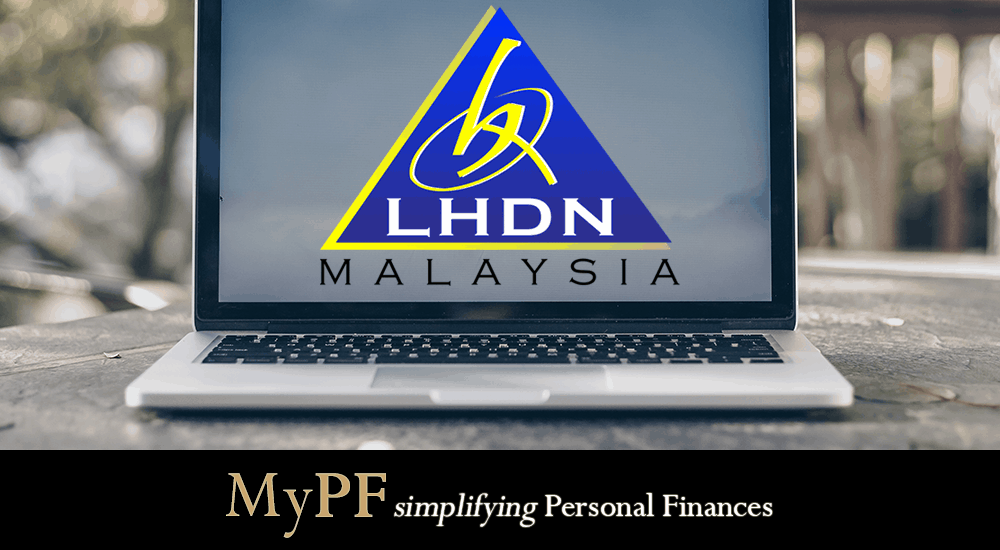

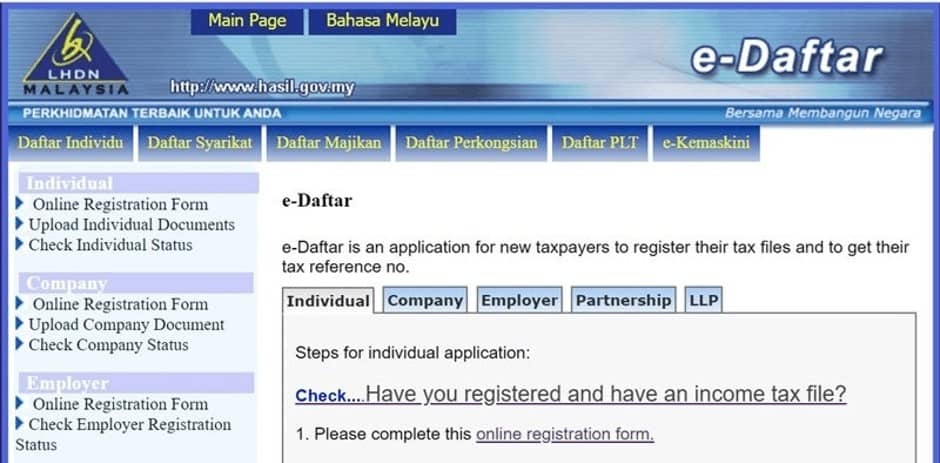
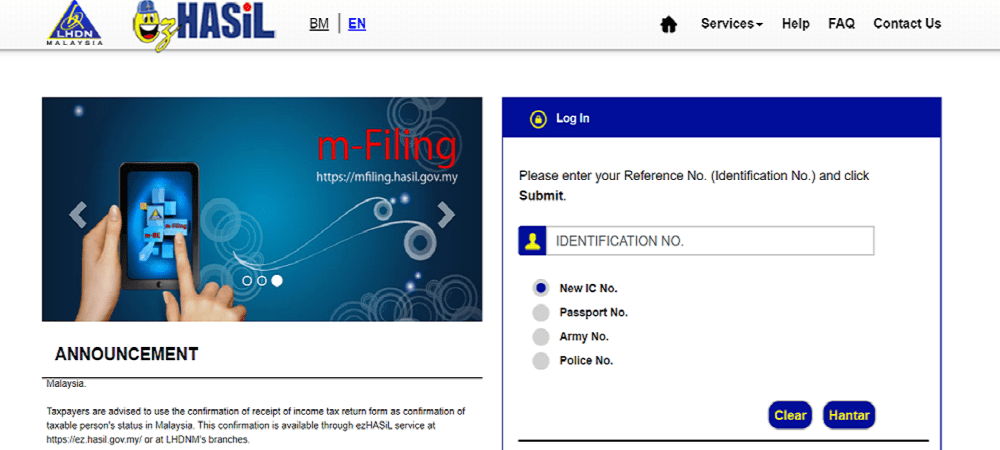
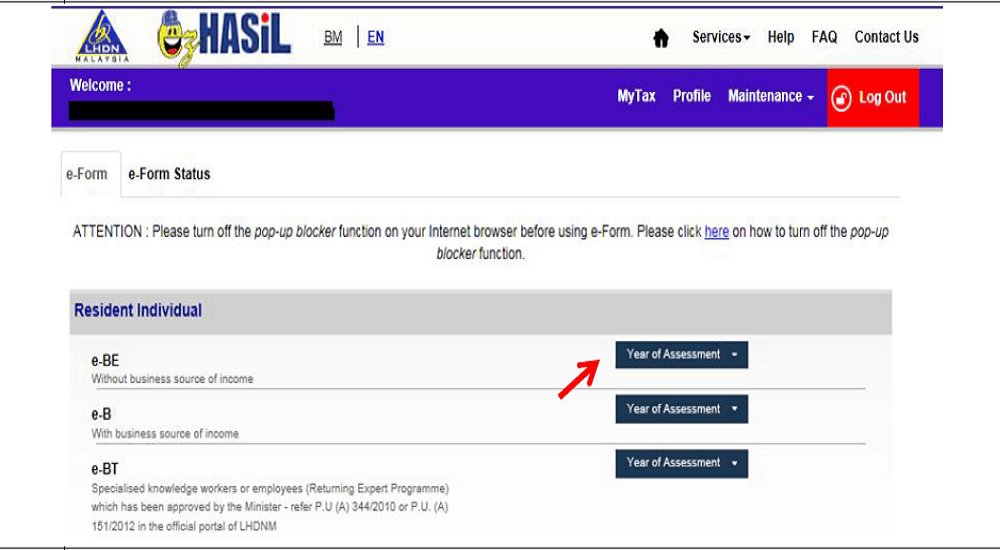
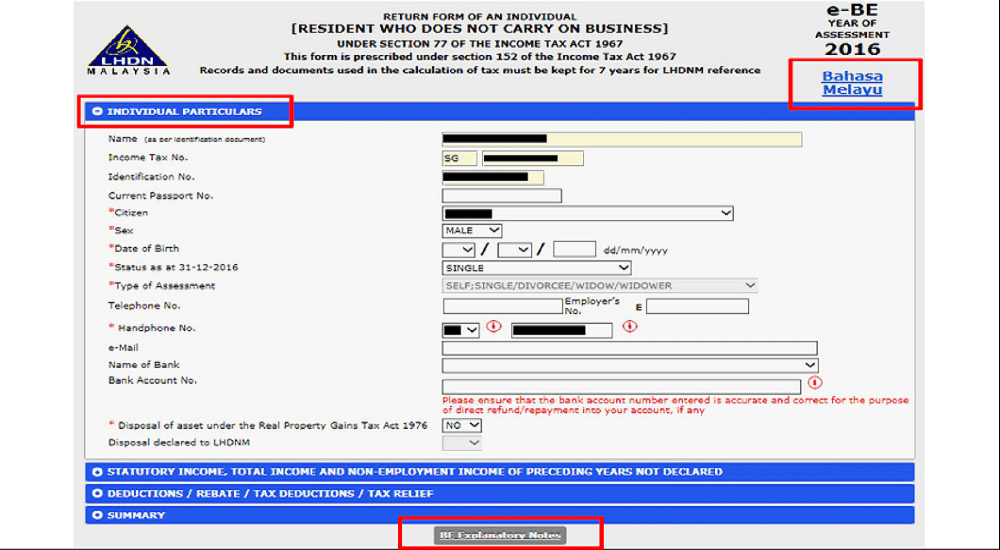
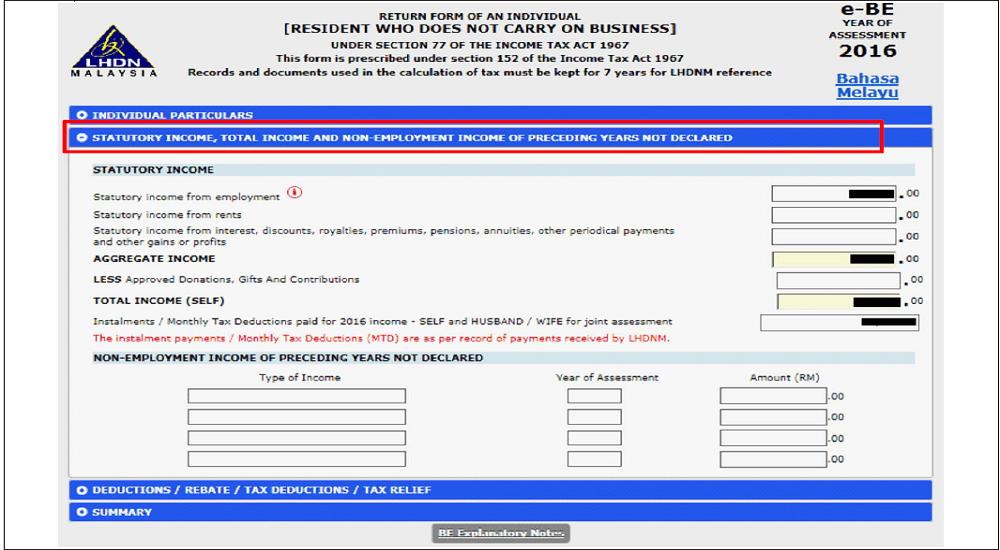
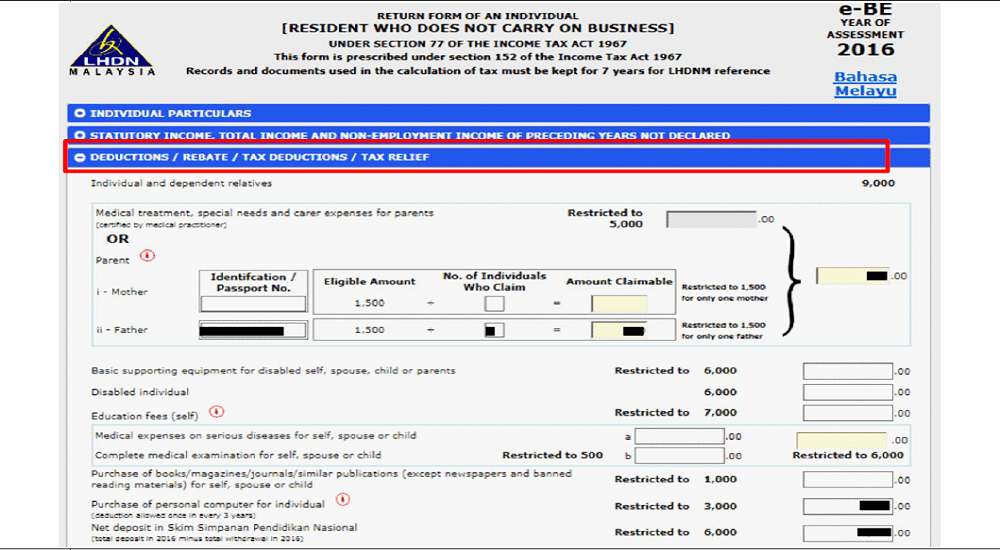
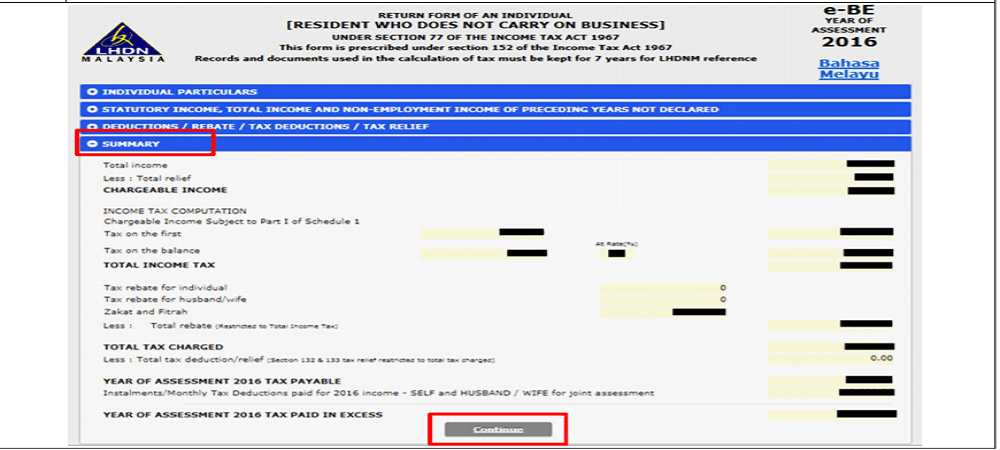

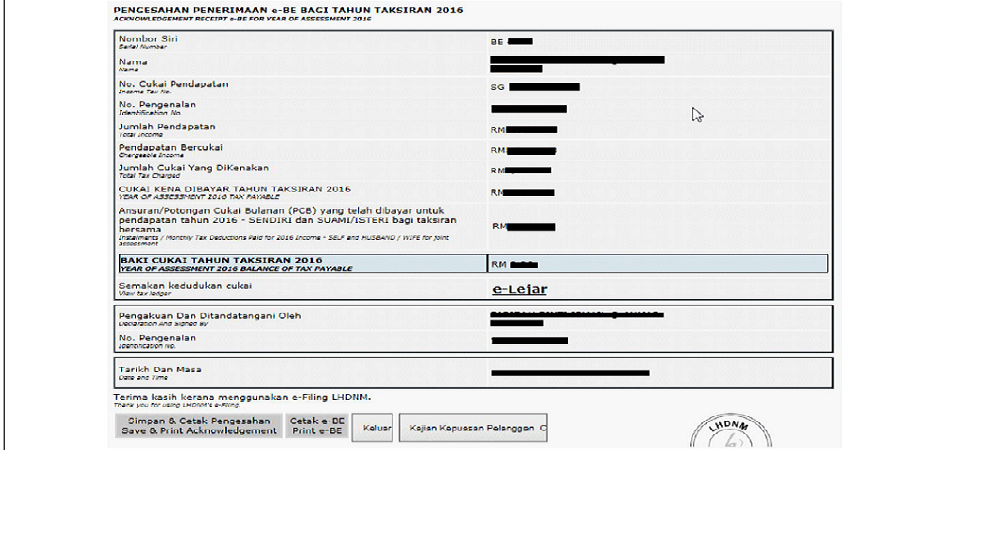




Hi,
I have submitted my form BE online but realised I made a mistake (I forgot to add my EPF contribution).
I then use the “e-Application for Amended BE” to amend my mistake. (but the “e-Application for Amended BE” doesn’t update the tax I should be paying)
The tax amount I should pay is the one before the amendment or after the amendment?
Hello,
I’ve submitted an e-BE form. After that, i found some mistakes made & tried to fill in “e-Application for Amended BE”, but its does not let me edit the amount i entered, it prompts: “The total income amended must not exceed the income reported in the e-BE”
May you help to advise on this?
Hi, I have a full time employment with another employer and also one of the partner in a partnership. I have already submitted Form BE on April, currently wanted to submit Form B, however system showed individual form had already submitted. Is it because I have to console employment income and partnership income together in Form B ? Thanks.
hi,
Good Day. Please could we seek your advise? Regarding the ‘e-application for amended BE’, is it could be used for when there is
1) Excess tax relief submitted
2) Less tax relief submitted
And is this only can be used before the last BE form submission of 30June?
Thanks!
What should I do if I realize I forget to include another income sources and some of the expenses to be claimed, but I have submitted e-BE 2019. Can I amend it online or must be through counter?
Hi,
My Tax number is incorrect in the Hasil.
What should I do.
Thanks,
Hi, I am not able to meet the deadline of June 30 for BE e-filing. What will be the impact of this? I will be visiting LHDN office soon to get my e-filing PIN. Any advice for me?
http://www.hasil.gov.my/bt_goindex.php?bt_kump=5&bt_skum=5&bt_posi=3&bt_unit=7000&bt_sequ=11&bt_lgv=2
i am not eligible for tax but i would still like to file a tax, is that possible? can i apply via e-dafter? or do i need to go to the office?
Hi, I am not aware that we have to do our own taxes (as previously we get represented) and totally missed last year’s filing. (but taxes was deducted from my salary)
What can I do to resolve this?
Hi,
What about EA Form – Section F – Elaun/Perkuisit/Pemberian/Manfaat Yang Dikecualikan Cukai. How to report this into the LHDN portal? Or no action required?
Government staff, opened a side hustle. The business only (sole prop) had income of 5k for 3 months. I have a staff who’s salary is 5k for the said 3 months. How do I declare this?
Hi I forget to print the acknowledgment so how can I reprint it?
Hi, I selected wrong part at section Child, suppose need to select Child-Disable (no study) RM6000 but wrong selected to Child-disable (Study) RM14000.00.
Still can do amendment for this mistake?
Hi how if the lebihan bayaran tahun taksiran was year 2018 , but i did not claim the tax refund .. if i submit will i get penalty?
Hi I’m an employed individual who having annual income lower than 34k and suppose to do my first income tax submission this year but MISS THE DATELINE. Can i still doing the e-filling or what i suppose to do the next ?
Hi. Just to check. If let say the penalty on late submission is 10% on tax payable (which is after 30th June 2020) . And if failed to report the tax and penalty imposed, 60 days from the final date (which will be effective from 30th June 2020?) Kindly advise on this
http://www.hasil.gov.my/bt_goindex.php?bt_kump=5&bt_skum=5&bt_posi=3&bt_unit=7000&bt_sequ=11
i just submit my e-filing today and is late for one day. the summary of tax shown i have paid extra. so will i get penalty?
Hi, i have a few questions:
1. I submitted online on 30/6/20 but paid the tax through bank on 6/7/20, will i be fined?
2. For Year 2018 income I did not submit BE form. How should i file the year 2018 tax?
Thank you.
Hello. Thank you for the article. I freelance online for foreign companies. Am I right in understanding that my income is not taxable, and I don’t have to file in my tax because I have no taxable income?
Dear Sir, have some question to ask.
1)Let say if the individual have no income in year 2019 at all, but have expenses, is it advisable to the individual to declare the amount for tax relief?
2)For employed individual, usually PCB or monthly tax deduction will be deducted by the employer. So if the total amount of PCB deducted monthly is correct, so the employed individual thinks that it is final tax so not obliged or compulsory to submit tax filing for the YA 2019 right?
Please advice.
Dear Sir,
I was a Grab driver until 2019 and have submitted tax return every year under Form BE.
My tax file was changed by LHDN from SG to OG last year and now am required to file tax under Form B which is new to me. I am now 71 and tried my best to do it before 31.7.20 . Half way through, I am asked to put the business code nbr. I am unable to proceed w/o it. Is it ‘49229’or ‘49230’ or something else. They sure made so complex !! My net income is only RM9,880 after after deducting fuel, car maintenance, communications charges. I would appreciate if you could please advise the proper code number for a GRAB driver who have no other business than just drive for GRAB. Thank you.
Dear Sir,
I would like to ask about PCB. This is my first time working, with a monthly salary of RM6000, my company deducted PCB RM301, however, when I check with the PCB calculator available on this website, it only states RM231. Just wish to know what is the difference in PCB amount and is that possible for me to claim for the extra amount paid when I file tax next year?
Hi, I’m a non resident staying in Malaysia since from March working for IT company. I heard that after 182 days of staying in Malaysia becomes resident tax payer then how much tax rates will be deducted after this period 102k is my annual income….. what are the other procedures I have to follow to get IT returns
Dear Sir,
I’m trying to submit e-Be filling but at the summary, I cant receive TAC even though I have registered at e-Kemaskini.
Countless try to get thru phone call but all I get is busy line since morning till afternoon.
Live Chat is no help either.
Please advise, Thank you
Hello,
Appreciate if you could answer my question. I am an employer under a company, a silent partner under a family business and also started an online business.
I get EA forms from my employers, I don’t take any salary from the family business (but have a share of profit/loss), and I work on the online business all by myself.
I know form B is a must since I have business income, however, do I have to submit form E for my online business even though I don’t have any employees?
Many thanks.
Hi, for Returning Expert Programme with 15% flat tax rate, what will be the correct e-filling form to use? And if there is late submission after 30 June, do we still allow to submit e-filling for 2019 and pay for the penalty?
Hi, I’m a consultant in oil & gas, I’m European, non resident in Malaysia, last year I worked 43 days in Malaysia and I was taxed 28%, I have since found out that if someone works less than 60 days a year in Malaysia they are not subjected to income tax. My question is, can I claim a refund for the income tax I’ve paid?
Thank you in advance for your advice.
Hello sir, i have submitted my BE form on 25 june successfully but i have’nt received my tax refund till now can you please tell me why?
Hi, i want to ask im close my shop on2014 until now。 And im marrried, got a kid. But past 2014vtill now never filling any tax, will i get penalty because i dont know once close shop still need to do tax. What should i do
I haven’t submit any income tax return (BE) before since I am a freelancer and that my commission is about RM2.2K per month.
Lately, I am planning to take up a housing loan but was told that I need to submit documents like Form BE which I have never submitted before.
Can I submit my Form BE for prior years and declare my commission on it? If so, how should I go about.
Thank you.
Hi, for investment on stock dividend received from listed company quoted in Bursa Malaysia. Does this have to submit as dividend income? For form B or Be
I helped my buddy to submit the form B yesterday and system hang out when submitting. Then the system not allow me to download the completed form copy. Any way to retrieve it back for me to print out?
Also anyway to file amendment of form E as I found that I have missed out the staff EPF amount….
Thanks in advance for the advice
I am a Malaysian based overseas. In my free time I do some advisory work and the fees are paid into my Malaysian bank account. Am I subjected to income tax ? The revenues will be more than RM34,000.
Hi, I’m a fresh graduate and if I start working in September 2020 does that mean I still have to file for income tax next year in May 2021 although I haven’t worked for one full year?
Hi, do I need to pay income tax for the money earned from the US stock market?
I am a working salaried employee. I am also a director and shareholder of company that i invested. if the company declared director remuneration and incentive to me; which tax form should i use. Thanks!
,can receipt for purchase of used smartphone qualify for lifestyle income tax relief of RM2,500
Hi, I have submitted my BE form end of May and received LHDN letter in mid of June that they need another 3 months for their further checking before they can make the refund. but I didn’t receive my tax refund or their feedback til now, any idea what went wrong? is this a normal practice for them to check further for more than 3 months? Thanks.
Halo
Saya telah bekerja dimalaysia 9 tahun tapi majikan saya tak pernah buat pemotongan pajak saya. Sekarang saya nak balek baru majikan saya uruskan .haruskah saya bayar atau majikan Saya musti bayar
Hi I have a full time job and on the side i started a sole prop but due to the pandemic there’s only expense no income (no salary either since own business), is it automatically assumed that there is no business income to declare? Do i need to change the tax form used for the next filing to include the business even if there is no income? Thank you.
Hi, hope you can help with my question. Thanks in advance.
I’ve started to work since April 2019, with the annual year 2019 income of less than RM25000 with no PCB deduction from the company. I understood with a total annual income less then RM34000 do not need to declare income tax, with your advice, do I still need to open a tax account and submit all the income documents?
I’ve started working in Malaysia in February 2020. I plan to quit my job in February 2021 and return to my country.
Is it only possible to get a tax refund through offline?
Or can I apply online?
The tax application period is usually March, so if it is March, I am not in Malaysia, so I would like to know if it is possible online.
If I can apply online, can I apply in advance in January 2021?
EA Form / tax Born / Form PCB 2 these form also necessary for applying through Online?
Hi, I already open up my tax file last year. but my annual income still below the limit and in this year i already change my jobs twice. Do i need to submit the BE form for this year? Or wait until my annual income at threshold limit?
Hi Sir, may I know will critical illness insurance claim received be taxed in Malaysia?
Hi,
The receipt of laptop purchase under education(eg Apple education) quality the lifestyle relief for personal?
Total income should be gross employment income before deduction including bonus and taxable allowance?
Good day sir,
I would like to seek for some advice for my situation.
I stay in Malaysia, but I’m working from home for a Japanese company in Japan, which they would wire transfer money into my Malaysia bank account, and my monthly is over RM 34,000 annually, should I fill for a personal tax?
Thank you very much in advance. :)
Hi, I only started earning more than 2800 a month in November 2019. Before that my income was only 1700 per month. But mid 2019 I joined a company for 1 month before quiting which income is more than 3000 but only month and unemployed until November 2019. I didn’t fill the form last year. Will I be penalised? I will fill the form this year as 2020 was the first year thats taxable
Hi, in 2020 i worked at oversea from Feb to Jul and since Aug unemployed till end of Dec. Previous year i filled file accordingly. Now should i fill tax file as well? Appreciate your advice. thank you
Hi, I worked as an employee for the past 5 years and has been filling up e-BE form.
1. In year 2020, I owned a house and rented it out, at the same time I paid for the maintenance fee and cleaning services as well as free them parking area which is considered as business income instead of rental income, am I right?
2. Although the total business income in 2020 minus the bank interest for 2020 and Quit assessment, I still have a negative cash flow, which I didn’t earn money. Should I include in e-BE form? If the answer is Yes, how should I put since it is negative? Or should I fill up another form?
3. As for my information, even though it is negative cash flow, it can actually offset my tax for employee income, is it true? If it is true, how should I do it, please?
4. I also invested in some stock in 2020 including REITS and I heard that REITS dividend should include in income too, is that correct? If it is correct, where should I fill in, please?
Thank you
HI,
I just done tax filing for YA’2020 and i got tax excess to be refunded frm irbm. But the problem is i got amount owing to irbm for YA’2019 as they pulled back some of my tax relief but for this i already request for instalment plan and irbm already approved. So my question is will i still get full amount to be refunded for last year (YA’2020)? TQ
Hi, Many thanks for your wonderful work here. I have one quick question. My son finished his university overseas summer last year. With this am I still entitle to the RM8000 relief under section F14b? Many thanks.
Is part time salary without any epf contribution (say rm 800 per mth) taxable ? The part time job is not long term.
I’m a Malaysian and work In a media company. I worked since 10 years ago and the company auto deduct my income tax in advance. So that I didn’t submit tax return for the past 10 years, what can I do now and what’s the penalty?
hi there. i just submitted my BE form yesterday but I forgot to add more tax relief (unifi subscription) to reduce my incometax. i tried to go permindaan BE form but it only allows to edit year 2020 and before. is that mean i can only edit it after the closing date of submission later?
Hi, I’m a student. I have just graduated with my degree last year. I have worked for 3 months and I resigned for further study. Do I need to register for a tax file and submit a personal tax form?
Hi ,statutory income mean net profit from business and plus disallowed expenses rite.